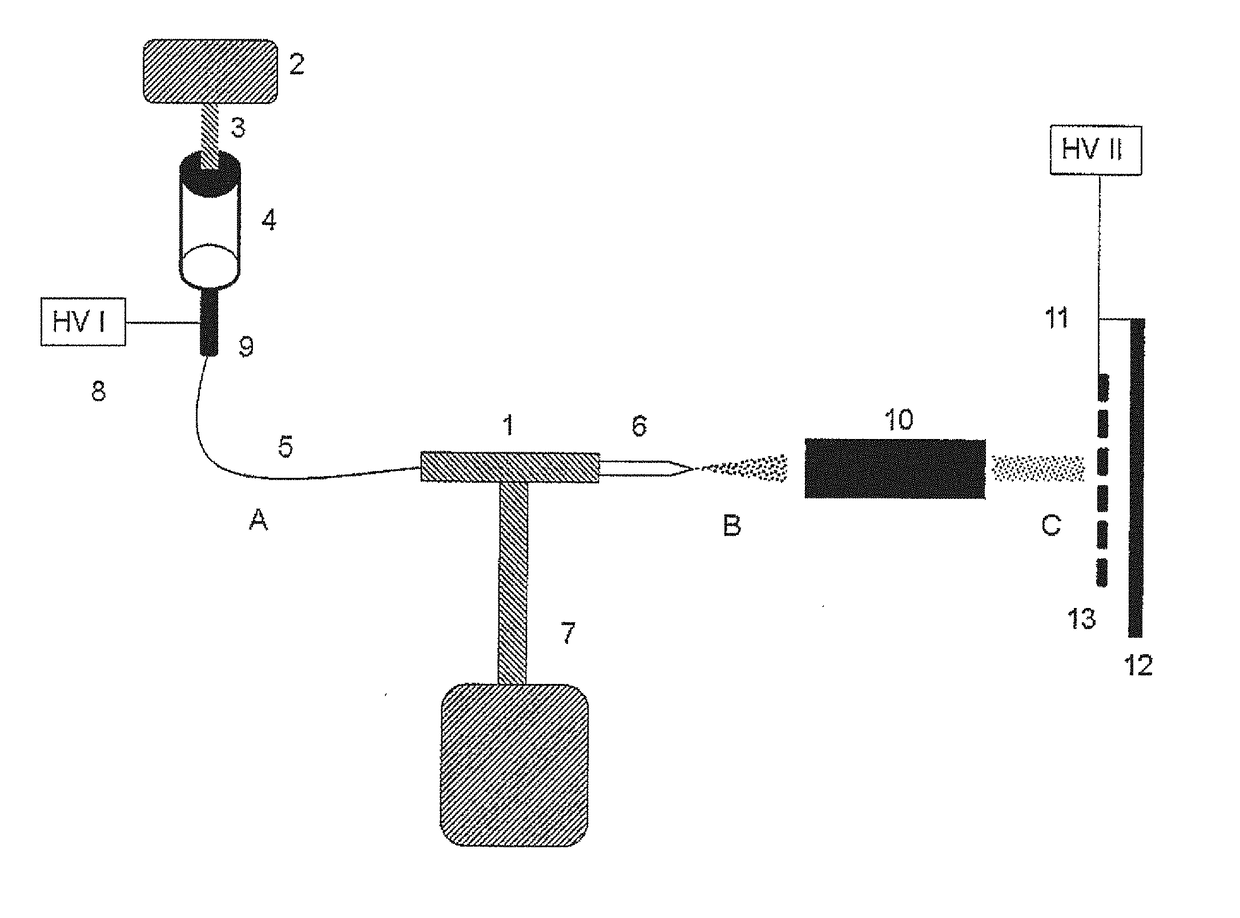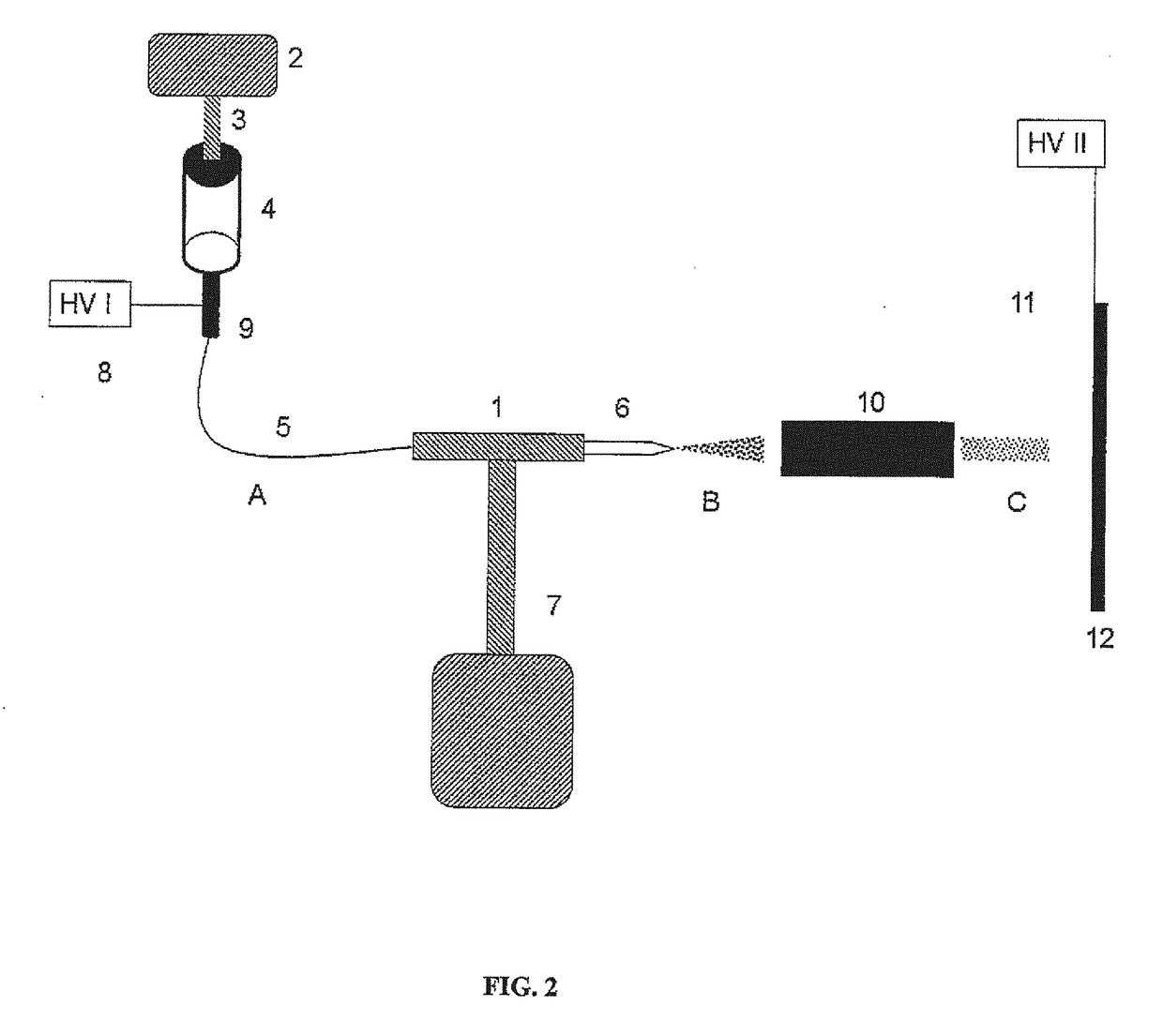Method of Surface Modification by Proteins for Analyte Preconcentration for Desorption-Ionization Mass Spectrometry Techniques and for Immunochemical Assays
a protein and mass spectrometry technology, applied in the field of surface modification by proteins for analyte preconcentration for desorption-ionization mass spectrometry techniques and immunochemical assays, can solve the problems of non-specific bonding of all proteins in a sample onto the primary gold surface, excessive length of the whole, and the inability to modify most metals (for example stainless steel or aluminium) directly with proteins
- Summary
- Abstract
- Description
- Claims
- Application Information
AI Technical Summary
Benefits of technology
Problems solved by technology
Method used
Image
Examples
example 1
Enzyme: Trypsin 23.3 kDa, Pepsin 34.6 kDa
[0038]The modified surface was prepared by performing the electrospray deposition and dry ions landing on the surface for 60 minutes according to the following procedure:
[0039]The values of the apparatus from FIG. 1 were set as follows:
[0040]Flow rate of the pump 2: 2 μL / min
[0041]Power supply 8 voltage brought to the conductive part 9 of the syringe 4: 1500V
[0042]Temperature of the tube shaped evaporation compartment 10: 80° C.
[0043]Power supply 11 voltage on the mask 13: −1500V
[0044]Pressure of the carrier gas inflow 7: 0.25 MPa
[0045]Carrier gas type: nitrogen
[0046]Carrier gas temperature: room temperature (21° C.)
[0047]Shape of the gap in the mask: circle; diameter=2 mm
[0048]The syringe pump 2 was filled with trypsin solution of the molar mass 23 300 Da (or pepsin, molar mass of 34 600 Da) at the concentration of 2 μmol / L in 5 mmol / L ammonium acetate, 30% v / v. acetonitrile (solution A). The high voltage power supply 8 was connected to the c...
example 2
Lectin: Concanavalin A 25.5 kDa Monomer, 102 kDa Tetramer and Wheat Germ Lectin (Wheat Germ Agglutinin) 17.5 kDa Monomer, 35 kDa Dimer
[0057]The modified surface was prepared by performing the electrospray deposition and landing of the dry ions on the surface for 12 minutes according to the following procedure:
[0058]The values of the apparatus from FIG. 1 were set as follows:
[0059]Flow rate of the syringe pump 2: 2 μL / min
[0060]Power supply 8 voltage brought to the spray needle 6: +1000V
[0061]Temperature of the tube shaped evaporation compartment 10: 55° C.
[0062]Power supply 11 voltage brought to the mask 13: −1000V
[0063]Pressure at the carrier gas intake 7: 0.25 MPa
[0064]Carrier gas type: nitrogen
[0065]Temperature of the carrier gas: 35° C.
[0066]Shape of the gap in the mask: circle; diameter=2 mm
[0067]The syringe pump 2 was filled with concanavalin A solution (molar mass 25500 Da) or wheat germs lectin (molar mass 17500 Da) of the concentration of 10 μmol / L in 5 mM ammonium acetate s...
example 3
Antibody: Anti FGF-21, Anti Leptin, 150 kDa
[0068]The modified surface was prepared by performing the electrospray deposition and landing of the dry ions on the surface for 60 minutes according to the following procedure.
[0069]The values of the apparatus from FIG. 2 were set as follows:
[0070]Syringe pump 2 flow rate: 2 μL / min
[0071]Power supply 8 voltage brought to the conductive part 9 of the syringe: +1000V
[0072]Temperature of the tube shaped evaporation compartment 10: 45° C.
[0073]Power supply 11 voltage brought to the surface 12: −1000V
[0074]Pressure at the carrier gas intake 7: 0.25 MPa
[0075]Carrier gas temperature: 30° C.
[0076]Carrier gas: nitrogen
[0077]The syringe was filled with the solution of leptin specific polyclonal antibody (antileptin antibody), molar mass 150000 Da, and concentration 2 μmol / L in 5 mM ammonium acetate, 30% v / v. acetonitrile (Solution A). The syringe with the Solution A was inserted into the syringe pump 2. The high voltage power supply 8 was connected t...
PUM
| Property | Measurement | Unit |
|---|---|---|
| temperature | aaaaa | aaaaa |
| voltage | aaaaa | aaaaa |
| resistivity | aaaaa | aaaaa |
Abstract
Description
Claims
Application Information
 Login to View More
Login to View More - R&D
- Intellectual Property
- Life Sciences
- Materials
- Tech Scout
- Unparalleled Data Quality
- Higher Quality Content
- 60% Fewer Hallucinations
Browse by: Latest US Patents, China's latest patents, Technical Efficacy Thesaurus, Application Domain, Technology Topic, Popular Technical Reports.
© 2025 PatSnap. All rights reserved.Legal|Privacy policy|Modern Slavery Act Transparency Statement|Sitemap|About US| Contact US: help@patsnap.com



